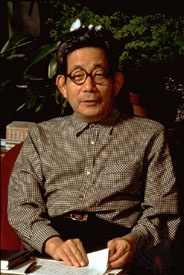Ōe Kenzaburō
Japanese writer
born Jan. 31, 1935, Ehime prefecture, Shikoku, Japan
 Japanese novelist whose works express the disillusionment and rebellion of his post-World War II generation. He was awarded the Nobel Prize for Literature in 1994.
Japanese novelist whose works express the disillusionment and rebellion of his post-World War II generation. He was awarded the Nobel Prize for Literature in 1994.Ōe came from a family of wealthy landowners, who lost most of their property with the occupation-imposed land reform following the war. He entered the University of Tokyo in 1954, graduating in 1959, and the brilliance of his writing while he was still a student caused him to be hailed the most promising young writer since Mishima Yukio.
Ōe first attracted attention on the literary scene with Shisha no ogori (1957; Lavish Are the Dead), published in the magazine Bungakukai. His literary output was, however, uneven. His first novel, Memushiri kouchi (1958; Nip the Buds, Shoot the Kids), was highly praised, and he won a major literary award, the Akutagawa Prize, for Shiiku (1958; The Catch). But his second novel, Warera no jidai (1959; “Our Age”), was poorly received, as his contemporaries felt that Ōe was becoming increasingly preoccupied with social and political criticism.
Ōe became deeply involved in the politics of the New Left. The murder in 1960 of Chairman Asanuma Inejirō of the Japanese Socialist Party by a right-wing youth inspired Ōe to write two short stories in 1961, “Sebuntin” (“Seventeen”) and “Seiji shōnen shisu,” the latter of which drew heavy criticism from right-wing organizations.
Married in 1960, Ōe entered a further stage of development in his writing when his son was born in 1963 with an abnormality of the skull. This event inspired his finest novel, Kojinteki-na taiken (1964; A Personal Matter), a darkly humorous account of a new father's struggle to accept the birth of his brain-damaged child. A visit to Hiroshima resulted in the work Hiroshima nōto (1965; “Hiroshima Notes”), which deals with the survivors of the atomic bombing of that city. In the early 1970s Ōe's writing, particularly his essays, reflected a growing concern for power politics in the nuclear age and with questions involving the Third World.
Ōe continued to investigate the problems of characters who feel alienated from establishment conformity and the materialism of postwar Japan's consumer-oriented society. Among his later works were the novel Man'en gannen no futtōbōru (1967; The Silent Cry); a collection of short fiction entitled Warera no kyōki o ikinobiru michi o oshieyo (1969; Teach Us to Outgrow Our Madness); and the novels Pinchi rannā chōsho (1976; The Pinch Runner Memorandum) and Dōjidai gēmu (1979; “Coeval Games”). The novel Atarashii hito yo meza meyo (1983; “Awake, New Man”) is distinguished by a highly sophisticated literary technique and by the author's frankness in personal confession; it concerns the growing up of a mentally retarded boy and the tension and anxiety he arouses in his family.
Additional Reading
Michiko N. Wilson, The Marginal World of Ōe Kenzaburō: A Study in Themes and Techniques (1986); Susan J. Napier, Escape from the Wasteland: Romanticism and Realism in the Fiction of Mishima Yukio and Oe Kenzaburo (1991).
- Aventinus
- Aventis
- aventurine
- average
- Average Capacity of the Braincase in Fossil Hominins
- Average Composition of the Atmosphere
- Average dose due to natural radioactivity deposited internally
- Average net primary production of the Earth's major habitats
- Average species life spans and extinction rates for various groups of fossil marine species
- averaʿ
- Averescu, Alexandru
- Averno, Lake of
- Averroës
- Aversa
- aversion therapy
- Avery Brundage
- Avery, Byllye
- Avery, John
- Avery, Milton
- Avery, Oswald
- Avery, Samuel Putnam
- Avery, Tex
- Avesta
- Avestan language
- Avezzano